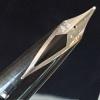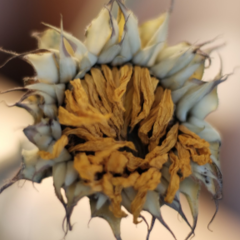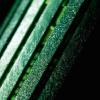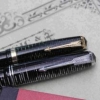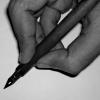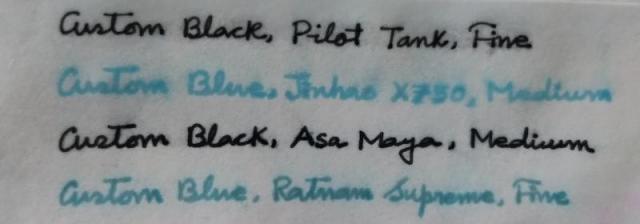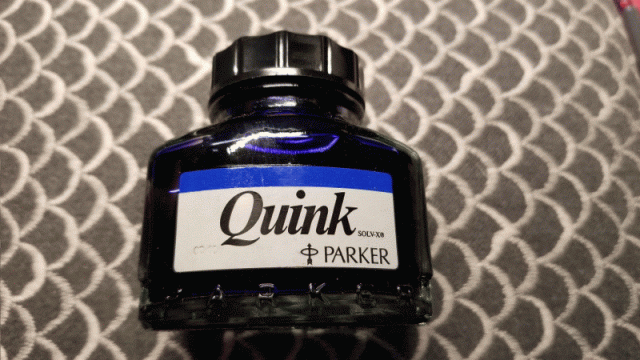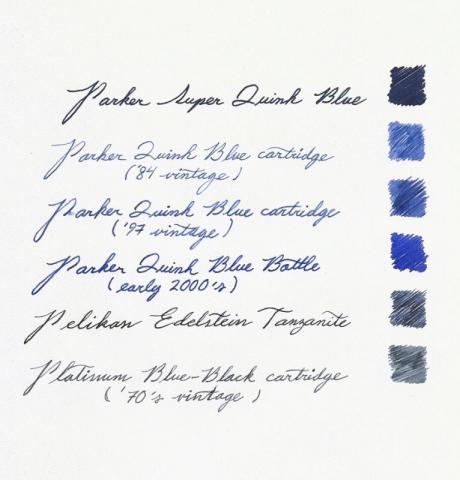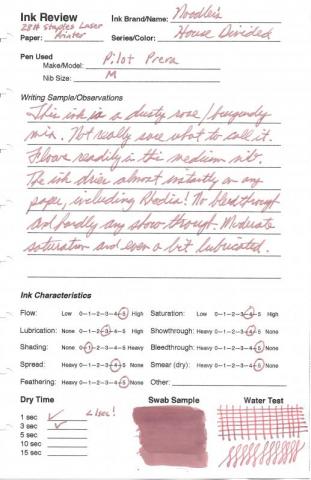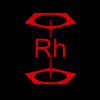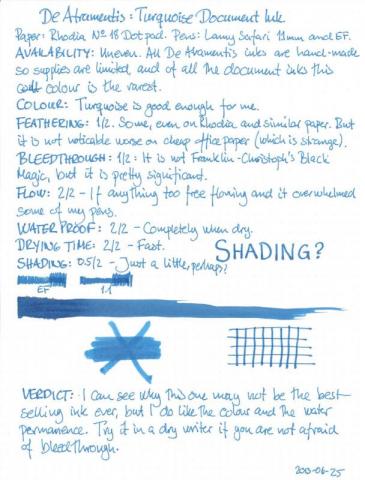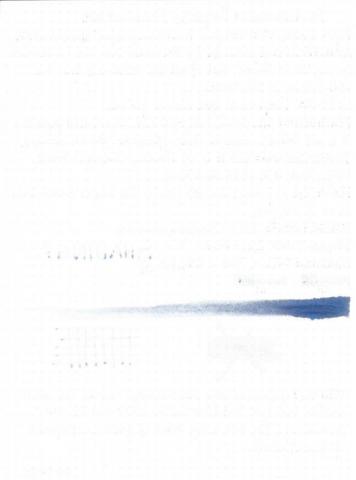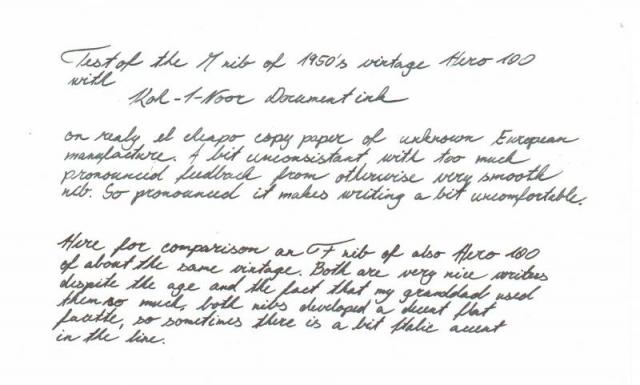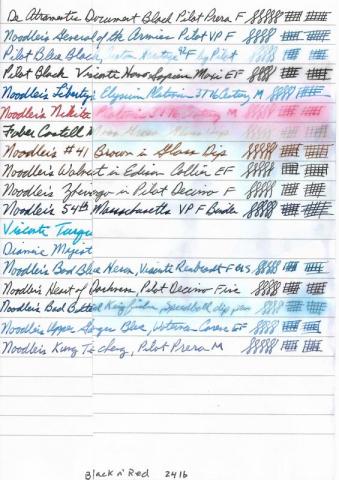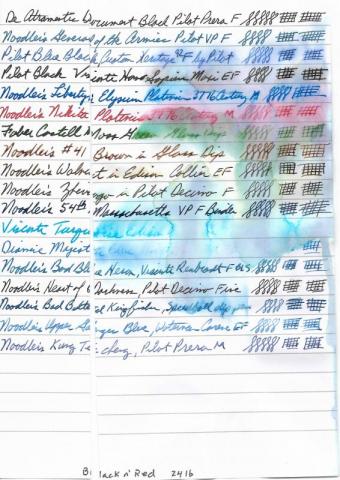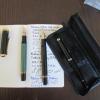Search the Community
Showing results for tags 'permanent'.
-
Hello! I have come to all of you for assistance, dear pen friends! I have been on the search for the perfect Blue-Black, one that behaves well on poor paper, one that doesn’t fade(like Salix), one that has a nice, saturated colour, and one that doesn’t make your nib size larger. (like Noodler’s 54th Massachusetts from what I have read) Thank you for all your help in advance! Cheers, Ian
- 67 replies
-
- blue-black
- students
-
(and 2 more)
Tagged with:
-
This 50ml bottle of Rohrer and Klingner's archival ink was not inexpensive, but performed well beyond my expectations. It writes wet, yet dries quickly. Is absolutely unfazed by water, and works on the cheapest papers. The only downside I have noticed is that while doing the crossword (yes, it works on newsprint!), it did hard start a little if I was too slow on a clue. It can hardly be faulted for that, though... Front: Back:
- 17 replies
-
- rohrer&klingner
- blue
-
(and 3 more)
Tagged with:
-
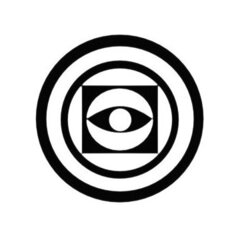
Which 'permanent' black ink would you recommend for use in EF nibs?
Mercian posted a topic in Inky Thoughts
Hi all, I mostly use western 'F' nibs, but have recently bought two LAMY Z50 nibs in EF, and I want to find a 'permanent' black ink that will work well with them. For the last several years I have used Noodler's Black as my 'permanent' black ink - it is very black, and very permanent, and I have always found it to be very good. Its only 'flaw' was its penchant for nib-creep. In the last few months though, I suspect that the ink in my bottle (which has been open since 2014) may have 'denatured' or 'gone off'. I found that the aerometric Parker "51" in which I have always used my Noodler's Black would no longer write when I put the ink in to it. It seemed to have dried-out in the nib. I tried my ink in one of my new EF Z50 nibs, and the ink gave me its usual nib-creep. But, after sitting in the capped pen unused for only two hours, it had dried-out to the point that the nib wouldn't write. The nib does write with Parker Quink Blue, so I am fairly certain that my bottle of the ink has come to the end of its usable life. After seven years, I'm not complaining. Anyway, it occurred to me that my need to replace my Noodler's Black is actually an 'opportunity' for me to try a new ink 😀 So, I am now asking for your recommendations for a 'permanent' black ink; one that I will be able to use in my pens with 'F' (and now also 'EF') nibs. I live in the UK, so my options are: De Atramentis Dokumentus Black; Platinum Carbon Black; Rohrer & Klingner Document Black; Sailor Kiwa Guro (carbon nano-particle ink); Or, if none of those are likely to suit my needs, a fresh bottle of Noodler's Black. I have read the reviews of those inks on here, and have seen reports of disturbing nib-creep and clogging for the R&K ink, disturbing bleed-through for the De Atramentis ink, and conflicting accounts for the Sailor and Platinum inks. Several of my pens are NOT easy to clean (especially the "51", but also the Safaris), so I would like an ink that is fairly easy to clean out of a pen, and won't clog up/dry out in a pen very quickly. So, do any of you out there in FPN-land have experience of using these inks in pens with F/EF nibs? If so, which of these inks would you recommend to me? Would you actually recommend something else entirely? My thanks to you in advance for your answers 👍 Slàinte, M.- 33 replies
-
- permanent
- permanent ink
- (and 4 more)
-
Blackstone Barrister Black is a new ink from Australian Vendor Justwrite It is a nano-carbon pigmented black that, like others of its class, is permanent, solvent-resistant/proof, and very well behaved. When I first got the ink for testing, it was labelled under it's pre-release name of Black 11.40, but having been released it is now called Barrister Black. On even poorer quality paper (old stock Reflex) there was no bleeding or feathering, so this is a very well behaved ink. As you can see, it is a deep, solid black, less matt and more glossy than the normal nano-carbon ink like Sailor Kiwaguro. On paper it looks more like Noodler's Heart of Darkness. I was able to test it by soaking samples in various household solvents, as below. So, for those of us in Australia who find that Sailor Kiwaguro or Noodler's Black/HOD are too expensive, or for those who want a carbon black ink that has an almost glossy look, this is a good alternative.
- 21 replies
-
- blackstone barrister black
- waterproof
-
(and 4 more)
Tagged with:
-
Anyone care to share their favorite permanent ink additive - mix of permanent ink + X ink ? While I enjoy Platinum Classics, Sailor nano pigs and Noodler's, it would be great to add a touch of permanence to the rest of my inks. I'm guessing Platinum Carbon Black would be a good stable additive but that was only one test run So far: Success: Platinum Carbon Black (just a smidge) + Noodler's 54th Massachusetts - stableFailure: R&K Salix + Maruzen Blue: the mix writes but precipitates all along the inner demonstrator barrel Ideal: Permanent reveal at 07:15 shows color washout but line is still visible. So the mix would be like this true Platinum Classic: color shows but when water is applied, at least the "permanent" iron gall burn still shows for archival review. https://youtu.be/kcWfuu05Dig Other mixes found: https://www.fountainpennetwork.com/forum/topic/293552-mixing-permanent-inks-with-inks-which-are-not/https://www.fountainpennetwork.com/forum/topic/135497-mixing-inks-sailor-nano/page-3
-
http://inks.pencyklopedia.pl/wp-content/uploads/Parker-Quink-Permanent-Blue-Black-old-nazwa.png Producent: Parker Series, colour: Quink Permanent Blue Black (old) Pen: Waterman Hemisphere "F" Paper: Image Volume 80 g / cm2 http://inks.pencyklopedia.pl/wp-content/uploads/buteleczki_atrament_parker_duza_old.jpg Specifications: Flow rate: very good Lubrication: good Bleed through: unnoticeable Shading: noticeable Feathering: unnoticeable Saturation: very good Ink drying time: ~ 5-10 sec. A drop of ink smeared with a nib http://inks.pencyklopedia.pl/wp-content/uploads/Parker-Quink-Permanent-Blue-Black-old-kleks.jpg The ink smudged with a cotton pad http://inks.pencyklopedia.pl/wp-content/uploads/Parker-Quink-Permanent-Blue-Black-old-wacik.jpg Lines http://inks.pencyklopedia.pl/wp-content/uploads/Parker-Quink-Permanent-Blue-Black-old-kreski.jpg Water Resistance http://inks.pencyklopedia.pl/wp-content/uploads/Parker-Quink-Permanent-Blue-Black-old-woda.jpg Sample text http://inks.pencyklopedia.pl/wp-content/uploads/Parker-Quink-Permanent-Blue-Black-old-txt.jpg Other tests carried out: Sample text in an Oxford notebook http://inks.pencyklopedia.pl/wp-content/uploads/Parker-Quink-Permanent-Blue-Black-old-Oxford.jpg Sample letters in a Rhodia notebook http://inks.pencyklopedia.pl/wp-content/uploads/Parker-Quink-Permanent-Blue-Black-old-Rhodia.jpg Ink drops on a handkerchief http://inks.pencyklopedia.pl/wp-content/uploads/Parker-Quink-Permanent-Blue-Black-old-chromatografia1.jpg Chromatography http://inks.pencyklopedia.pl/wp-content/uploads/Parker-Quink-Permanent-Blue-Black-old-chromatografia2.jpg
-
Hi all, I've been slow on the uploading, but here is the third of three reviews of the new (Oct '13) Montblanc inks. Some of the text on the background is copy and pasted, this is in grey should you want to skip it I see some of you have already checked out the Flickr album! Montblanc seem to be shaking up their line a bit, Midnight Blue is no longer listed as being a permanent ink and two new permanent inks are being introduced. The packaging is the same format as the existing inks with new graphics, All white with blue and black text. The bottle is the same shoe as we are used to with the existing line up (with the nice two part filling arrangement). http://farm6.staticflickr.com/5477/10108346353_779b6d73ca_z.jpgIMAGE_1.jpg by Bigeddie100, on Flickr Included below are samples of the new ink, and some from Mystery Black for comparison. My scanner is now older than some forum members, that is to say rather tired. I have taken photos in direct sunlight for comparison. Both inks were in Lamy Safari pens with medium nibs. http://farm8.staticflickr.com/7381/10116588723_c5577df8a6_z.jpgMontblanc Permanent Black on copy paper by Bigeddie100, on Flickrhttp://farm4.staticflickr.com/3788/10116533925_da7d9bebf0_z.jpgMontblanc Mystery Black on copy paper by Bigeddie100, on Flickr http://farm3.staticflickr.com/2820/10116512226_fa55819151_z.jpgMontblanc Permanent Black on Rhodia by Bigeddie100, on Flickrhttp://farm8.staticflickr.com/7380/10116525525_6451b35e04_z.jpgMontblanc Mystery Black on Rhodia by Bigeddie100, on Flickr Analysis: The new black has a much heavier flow than Midnight Black and a more intense depth, it is truly black. I would rate it on blackness with Noodlers (bulletproof) Black or Sailor Kiwa-Guro, whereas the Mystery Black has quite obvious shading, to me the sign of a not black black. Performance is good despite the heavy flow, even on cheap paper; the same caveats as the Permanent Blue here, it looks like single sided use only due to the bleed and show through, but there is very little feathering. Performance on Rhodia is superb, with a deep black, good lubrication. Water resistance:These new permanent inks from MB are the first that I have seen with an ISO certification for permanence, here I am only testing water resistance when dry. The inks proved to be very water resistant, I would be hard pushed to detect the difference between inks before and after soaking. Certainly this ink along with the new Permanent Black are the most water resistant inks out there, unlike the pigment inks nothing floats off of them. But the black does rub off, a little bit. After a two hour soak (photo to be added) I could rub some of the black off, legibility is still excellent, far ahead of that of the old or new Midnight Blue inks, and miles ahead of Mystery Black (which disappears after a 5 minute soak, as below). http://farm4.staticflickr.com/3747/10116653463_80c76125ea_z.jpgWater resistance in progress by Bigeddie100, on Flickrhttp://farm4.staticflickr.com/3764/10116561223_bec75a871d_z.jpgWater resistance by Bigeddie100, on Flickr Conclusion: This is a nice black. The down side, as with the Permanent Blue, is that it's £19 a bottle. For a good permanent black ink I would go to Noodlers black (90ml currently £12.50 from Niche Pens) or Sailor Kiwa-Guro (50ml around £16, The Writing Desk or Write Here). It's nice enough but not very remarkable for the money, and both of the other two have better performance for use double sided. I look forward to your opinions
-
This has probably been asked before a gazillion times, but I cannot find a definite answer on FPN or elsewhere. I've got two bottles of Parker Quink ink, one black and one blue black. I think both bottles are the same, the labels have different designs and the boxes are different, too. I don't know whether this is because one is washable and the other permanent, or because of a change in the design. Are these inks washable or permanent? I've read that if they are washable the box would say so, but I'm not completely sure it's like that. Thanks!
- 17 replies
-
- parker quink
- washable
-
(and 1 more)
Tagged with:
-
I have a bit of a hangup for permanent inks, and this is often at odds with my passion for vintage pens. Do you think I'm going to take apart a Parker Vacumatic, clean it, replace the diaphragm, admire the clarity of the barrel that has survived for 70 or 80 years, and then fill it with Heart of Darkness? No. That is not happening. I love HoD, but that goes into modern pens that I don't really give a darn about. Inks with no water resistance are uninteresting to me. Yes, I have a bottle of Waterman Serenity Blue. It's used for dip tests after I refurbish a pen, but there is no way I would write in my journal with it, the audience for my journal is my family, but a hundred years from now. Dr. Murphy would assert that it's basically impossible for a journal to survive a hundred years without being subjected to some spillage of liquid, and the likelihood of spillage is probably higher around me, considering the amount of coffee I consume daily. So... First, I'd like to know your opinions on the 2 inks that I do use: Platinum Blue Black (the regular ole' dye-based version, not the pigment-based version) and Platinum Forest Black (good old iron gall, which I assume was used a good bit on any older pen before I got to it). Is there any sound reasoning or scientific evidence that would tell us not to trust these two inks in my vintage pens? Next, I'm looking for a black. As stated, I have Heart of Darkness, but I just couldn't put that into an old Vac. I have a bottle of Pelikan 4001 Brilliant Black that came included in an eBay auction, and I probably will never open it, not in all my life, because it's not permanent at all. What if the ancient Egyptians had used such junk to write on their papyrus? What if the ancient scribes had used impermanent ink to copy the Torah? Imagine all the culture we would have lost to the eons. My current options for black inks are: "GRAF VON FABER-CASTELL CARBON BLACK DE ATRAMENTIS ARCHIVE INK DE ATRAMENTIS DOCUMENT INK - BLACK" To be clear, I'm open to hearing about any permanent inks that will not kill the rubber internals or celluloid walls of old pens. When I say "permanent," I don't mean "eternal and unmoving," but it would be nice to know that if it falls into a river and I fish it out, that what is left when I dry the paper will still be legible. Your suggestions?
-
I happened upon some new-old-stock bottles of "Waterman's Permanent Blue Black" ink. They were in pristine condition, and the cap sealing was good such that no ink appears to have evaporated. I see no precipitate or any other issues. The ink has a chemical scent I can't quite identify accurately, but it makes me think of paint and art supplies, for the lack of better description. I don't know if this ink has any amount of iron gall or not, but I suspect it has a small amount. If anyone wishes to contribute to this ink's description and dating, it would be great. The bottle has the following embossed on the underside: There are no visible dates on the bottle or the carton, but the following is stamped on the inner side of one of the carton flaps in black ink with silver shimmer--and it's difficult to read. Box #1: Box #2: The ink itself goes down on the page in a cool-toned (with a very slight purple tinge) hue of medium saturation and then dries to a muted very slightly teal-tinted blue. The color change is gradual over the next day or so to what you see on the photographs. The final color of the ink is quite consistent with the bottle cap. I can't explain why that is, but, subjectively, the color of this ink feels just right to me -- a classic. The water resistance test was a wash under running water, 3 days after the writing was done. I really like the look of the paper towel "chromatography" -- medium blue fading to slightly more cyan vintage light blue to almost cream. The more ink is concentrated, the more the blue is shifted toward green, as can be seen on the Col-o-Ring card. There is some red-magenta sheen. Not sure if I am going to hold on to both bottles yet--I got them out of curiosity, but it turned out that the ink inside was surprisingly good. And the bottle, along with the carton, look great on my desk. That "19 cents" printed price
-
I have been thinking about mixing relatively inexpensive inks from India to produce something I can use in my writing. I have to be conservative with my choice of ink for official use- only black/blue-black, and my writing should be somewhat impervious to water damage. In my personal use, I prefer a vibrant, unusual blue ink. I have two ink mixes ready for experimentation. I. 3 parts of Daytone Turquoise Blue + 1 part of Camlin Royal Blue = Custom Blue. II. 3 parts of Daytone Calligraphy Black + 1 part of Camlin Permanent Black = Custom Black. The first photograph below is how the inks behave in different pens on ordinary 75GSM copier paper. The next photograph is the result of water resistance test done after 12 hours of writing. The paper is kept under the stream of tap water for 1 minute and then submerged in a mug of water for 30 minutes.
-
I have recently ventured into the world of vintage pens and have purchased two English Parker 51s for use as EDC/workhorse pens. I also picked up a few bottles of vintage Quink Permanent Blue with Solv-X that were made in England as I figured the ink should most definitely be safe to use in a Parker 51. I'm a blue ink girl at heart for my everyday inks, and tend to avoid black inks. Blue-blacks are hit or miss for me. I used to use Quink Washable blue back in my college days and discovered from unpleasant personal experience that it fades very badly. Sadly, I documented a significant portion of my flight time in my logbooks during my undergraduate flight training hours in Quink Washable Blue and those entries are now barely legible. Fortunately, enough of my logbook is in other inks, mostly ballpoint, that it's still usable as documentation of my flight time. I no longer fly professionally, so I am not concerned about the longevity of the entries as much anymore, but I would like to prevent similar ink fade in my current logbooks for flight and scuba diving, as well as in journals, record keeping, and correspondence. Just how permanent is the Quink Permanent Blue with Solv-X? Will I need to worry about significant fading, or is it pretty hardy? I have also purchased some Rohrer & Klingner Scabiosa and Salix inks, but wasn't sure they would be good choices in the P51 pens due to them being harder to completely dismantle and clean should the collector clog with the IG inks. I intended to use them in other more easily cleaned pens. Are my instincts correct to avoid IG ink in a P51? I've attached photos of the box and bottle here so you can see the ink. There's no date on the box or bottles, so I am uncertain just how old the ink is, but my guess is not terribly old. The bottles are 2 fl. oz., or 57 cc.
-
Well this may be the most boring ink review you've ever seen. Sailor Kiwa-guro is a permanent black ink based on nano-pigment instead of a dye. I presume this means the pigment particles are much smaller than usual for pigments, but not so small to be a dye. There may be other factors that contribute to this ink being permanent, but it is not an iron-gall ink. The ink is totally waterproof, and if the pigment is a permanent black, then it will also be lightfast. An interesting FP ink it is not, in that it doesn't shade really, and it doesn't sheen. It's quite a flat black color. Even the ink droplet chroma is boring as I think I was also running out of the fill at the time and didn't get a full droplet(s). I have to admit I still like the look of a black ink on paper. This may not be the blackest of black inks, but it perfectly appears as black.
-
Just got hold of several old bottles of Parker Super Quink Blue ink that came in cheap looking, black plastic bottles that look nothing like Parker Quink ink -or any other ink for that matter! They were manufactured in Parker's plant in Mexico sometime in the 1980's and they differ from their American counterparts in that there's no mention of Solv-X in them -which from what I've read, these inks had- and it only states the ink as permanent. Upon opening the first bottle I found that evaporation took the better half off it and that it has a chemical aroma that is not present on any other ink I've tried so far. So being a cautious guy, I proceeded to fill my trusty old and cheap Manuscript Chinese pen with the liquid and give it a try. I followed the recommendations of fellow FPN users on testing that the ink had no strings attached while submerging a stick into it. I also made sure no mould or other foreign items were floating around. So after using it for a while, I found that the ink colour is more blue-black or dark blue than anything I've got on my ink stash, so I decided to compare the ink with other old cartridges I have from pens I recently bought in NOS condition. And here am attaching the result. Not of a big fan of blue hues, but in this particular case, I kind of love how dark and saturated this ink is. I had since refilled the bottle with distilled water in order to restore the original volume, but I've yet to try the diluted version. I'll post updates as soon as I fill my tester pen with it. What do you all think? PS Sorry, forgot to attach the image
- 15 replies
-
- parker
- super quink
-
(and 6 more)
Tagged with:
-
Hello everyone. I'm new to this. Is there a permanent ink that does not clog or dry in the pen (nib?) if the pen is not used for a week or more? And, a permanent ink that flows well, is "wet", and easy to clean out of the pen? If I only use the pen several times a month for check writing, etc, is that enough? I have several Pelicans, a Sailor 1911, and a couple cheapies. Thanks so much for your help. Newbie here. Aloha jim
-
Just got back from the DC Pen Show. Several retailers had the latest Nooder's ink, House Divided. From his description, I was expecting a reddish blue ink that when washed leaves behind a permanent red line. I was able to sample the bottle at Luxury Brand's table. The ink is not what I was expecting. It is actually a dusty rose/burgundy color with barely a hint of blue in it. I came home and immediately loaded it into a Pilot Prera medium pen and did some testing. I also did a spill test during which I wrote on a piece of 28# paper, let it dry, and then poured tap water over it. After it dried, I scanned the image and it is included below. Observations: This is a very permanent ink! It is somewhere between Noodler's Empire Red and DeAtramentis Document Red, maybe with a hint of Kung Te cheng. The spill test and the water drop test barely washed anything away. Placing a couple drops on the Review Sheet and allowing them to dry without blotting caused a hint of blue coloring to flee to the water's edge, but barely a noticeable change. If you are looking for a permanent dusty rose ink, this is a good one to look at. Flow is excellent, no bleed through, and barely any show through. No feathering, but a bit of spread on the 28# copy paper. I tested it on Rhodia, and it behaved very well. Dry time is less than 1 second, even on the Rhodia! I bought my bottle from Federalist Pens at the show. At least one other retailer had the ink at the Show. I would guess it will be available on-line from the vendors who carry Noodler's.
-
Nathan Tardif sent out a news release about his latest ink named "House Divided". The description sounds like a semi-permanent purplish ink with a blue component that washes away leaving behind a permanent red line. His announcement indicates it will be available for the DC Pen Show. I plan to attend Saturday and will be looking for a bottle.
- 20 replies
-
- dc pen show
- permanent
-
(and 1 more)
Tagged with:
-
Hello all! I don't really know which category this falls into, so i'll post it here. I'm looking for an ink that is dye based, relatively fade/water resistant, that does not corrode a pen if filled for an extended time (let's say 2-3 weeks) and is blue/blue-black/black (or any other color you would consider as work appropriate). Any recommendations?
-
This is a permanent (ISO 127755-2) ink in the "Document" series from De Atramentis. Availability is a little uneven: all their inks are proudly "hand made" and so stocks may change, but this one seems more uneven than most. If you have a really dry writer this one may be for you. All the Document inks are quite free flowing, but this one the most so of those I have tried. Bleed through is pretty bad - nowhere like Franklin-Christoph Black Magic kind of bad, but still. And the back page for bleed-through: Hope this helps someone. Happy writing / drawing / doodling: whatever you do, use fountain pens!
-
Koh-I-Noor Hardtmuth is a famous manufacturer of (not only) writing, scribing and painting "tools" and accountrements of all kinds, with over 200 years of continuous history from former Austro-Hungarian Monarchy to current Czech Republic. Their sortiment is broad enoght to cover whole range from hardcore development engineers through different artists by trade to hobby pencil cartoonists. This company is the original, first succesfull creator of todays most simple and notorious writing instrument-a graphite pencil in a wooden stick. From the brief above is quite clear, that Koh-I-Noor is realy not specialized in inks. They have a basic, but usefull range of comon grade writing and india inks in several colours, but kind of "just by the way", they have in portfolio Koh-I-Noor Document Ink Black I can´t say what is it based, as this is kept secret as far as I know. It is not an iron-gal ink, it is not a graphite ink, no way it is a more stable breed of "coloured writing lotion". Probably it is one of the few formulas which work with chemical interaction with celulose in the paper. The colour is dark grey-black or black-grey with distinctive greenish hue, depending on paper and pen combo. It darkens over period of several minutes to several months into flat black with greenish hue.The more it darkens, the more it is resistant to any kind of wash-out. It is awarded ISO 14145-2 and BS 3484-2. The latter is a British norm for permanent record inks, and as the Brits are quite hardcore (another word would fit here better...) about what to consider "permanent record", it means quite a lot. I´m not sure how much pH neutral it is, but will update if I get the info. The ink is a bit more viscous than most others, but flows very well and have some lubricity. Basic Parker Quink feels like running water with no lubrication in compaison, from my point of view on distant memories-but keep in mind this is nib-affected feeling. The viscosity causes very little feathering, even on most low quality papers, but also makes fine nibs to produce M line on some quality papers due to surface tension effects. But the width of the line is consistant, no blots. Frankly, no blots at all, except some realy poor papers or papers of very fibrous nature with "open" surface (like kitchen towels...). Flows well, on some papers almost too fast for my taste, but still not like eg. Quink. Due to its nature, after about 15-30 seconds, depending on the nib, it tends to develop a bit of "skin" and makes the pen a false starter. If the nib has a "baby bottom" grind, it can be realy troublefull to start it again. From wet nibs on quality paper, it produces a realy deeply saturated line, embedded to rock bottom into the paper. From dry writers, it can be kind of greyish, but this realy does not alter the endurance of the line. There may be some trouble with drying up the nib in some F writers with smalish and/or fine compartmented feeds during prolonged period of fast writing. On most papers, is dry almost instantly (2-3 seconds). I posted some general info about torture tests I subjected this ink to, from 2008 to 2014. The post is in the Inky thoughts section, here: https://www.fountainpennetwork.com/forum/topic/288624-koh-i-noor-document-fountain-pen-inks/page-2?do=findComment&comment=3723625 I must add, that the statement "does not clog the feeds" is OK, but after some testing, I´m sure I wil have to give a good bath to my pens, as the M nib Hero 100 writes dryer now than it should. Well, I used it very sparsely in the last 3 years, albeit it was freshly inked all the time. The abuse this ink can stand is simply unbelievable. The paper vanishes, the ink remains. No matter how do you make the paper to vanish. This says it all. Some people (with degrees in chemistry) claims that this ink is probably the most durable against sun fading ever created, if good, uncoated paper with low filler content is used. Here I will quote myself from the above linked post: Several weeks ago, a clipboard with a day worth of important notes (on poor copy paper, 80g/m2), already a bit soaked in the rain, faceplanted into soaked, liquid clay in a ditch. All was covered to no avail under ochroid mess. So I took it home in a plastic bag, washed the paper gently and recovered every bit of info I had written. This says a lot, when I add the paper was more yellowish-brown-ochroid than white as formerly was... The text was not affected at all. The pens used in the standard review sampler are both Hero 100 of 1950´s vintage, daily writers of my grandfather for some 2 decades, now exclusive daily writers of mine for 8 years. My granddad used them so much that a definitive facette has developed on both nibs, which gives a kind of italic accent to the line, as my writing angle is a bit different to grandpa´s-but close enought to apreciate how smooth gliding writers they are, especialy on vintage paper. The water test-I tried to lay down as rich line as I could, to promote the greenish hue which sometimes apears from this ink on some papers, without any shade of compromising readablitiy of the text. So I wrote about one letter in two seconds the top three lines, the bottom in just slow pace-as writing slow, I write even worse pattern than usualy. The test was performed for about 1 minute under hot running water (like 70°C), then soaking like 5 minutes in a bowl of that hot water and rubbing the bottom line with finger. The paper lost the top layers, is one fluffy spot there, but the text is still there. And by the way-there is no alteration to the text after two years maceration in much more agressive solutions than hot tap water... Generaly, I should apologize for the lack of penmanship screaming out of the paper, I used my pens not as frequently as I was used to in the last 3 years (gap in journaling etc.), no practice either... Also, the sampler was printed with a poor toner cartridge, so the thin grey lines are more nonexistant than anything else, so both samples are freehanded, more in a bit of hurry. The ink is availible in Czech Republic 50 ml plastic bottle for less than 1 EUR to 1,75 EUR equal, depending on greediness of the stationery clerk, or in a nice, simple glass bottle of 30g for 3,5 EUR. On other markets, the price is usualy similarly low, as far as I know. It is one of the cheapest inks I´ve ever seen, but of the most durable and bulletproof you can ever have. There is also a blue version on the market, which is not as much durable and was created, as far as I know-because of demand for "nice blue document ink, not that greyish feculence you sell". But there are traces of fading even after just 1/2 year on direct sunlight, which is nonexistant with the reviewed original black formula.
- 2 replies
-
- koh-i-noor
- document ink
-
(and 5 more)
Tagged with:
-
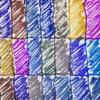
Please Advise Me On Black Ink For Official Records; Must Not Feather
Pensei posted a topic in Inky Thoughts
I'm not a doctor, but on occasion in my work I write notes in old-fashioned paper medical charts. The hospital's only rule is "black only." Everyone, to my knowledge, uses ballpoint or the occasional rollerball. If I'm going to use FP ink, it will need to meet these standards: black, waterproof, photocopiable, permanent (these records are kept forever), and fast-drying enough not to smear if I have to pass the page to someone else as soon as I finish. Now here's the angle that makes me think I may be looking for a unicorn: these pages are printed on horrible copier paper, the worst you can imagine, so what I use must be non-feathering, and non-penetrating both in terms of bleed-through or see-through (both sides of the paper are used). If any of these standards are not met, I will have broken federal privacy laws and hospital record-writing rules, and lose my job. No joke. Is there a doctor in the house? Or perhaps I should say is there someone else who is in this situation, because doctors probably have enough status at our place to write in crayon if they wish. Yeah, I searched, and the variables here, in my opinion, introduce a valid new discussion. Final comment: I'm willing to dedicate a pen to an IG ink if that's the answer. Thanks in advance for any advice.- 43 replies
-
I use my fountain pens at work daily. I've had too many encounters with spills and drips on my notes to make me wary of what ink I use. One event, in particular, stands out for me when I wrote something down on a piece of paper for someone to refer to. Later, I saw the note on his desk. He had dripped some water on it, and the ink had run all over the place, not even legible! Embarrassing. It's one thing to be retro and insist on using my fountain pens at the office, but it's another when it affects the quality of the work product. So, I've been on a quest to find inks I can use reliably for work and not worry about accidents happening to destroy the writing. I have quite a lot of inks in my collection. with even more samples. I selected some inks that I've been using lately along with a couple I like, but have had bad experiences with their lack of water resistance. I use a lot of Black n' Red notebooks at the office, along with copy paper. I also wanted to compare performance with a premium paper, so I selected Rhodia. The tests consisted of generating a baseline for the three papers and 18 inks. I scanned the images at 600 dpi into jpeg files. They were later down-converted to lower quality jpeg to come in under 1 MB file size. I cut each sheet into two pieces - a control and a test side. After each test, they were scanned with the control and the test side together to provide a good comparison. The first test consisted of pouring a stream of water over the paper for a few seconds and then allowing the paper to dry without touching it. This simulated a spill at work and represents my biggest concern. The second test was for permanence. It was an 8 hour soaking in a water bath with some agitation to slough off any loose ink to see what actually remained behind on the paper. I'm posting the two test results and not the original because each test has its own control side to compare with. There are several ink brands that make water resistant inks. I've posted scans of some others previously (including Platinum). These are the inks I've been using lately as I've narrowed my preferences. One factor I've been looking for is quick drying inks so I can write and quickly turn a page without it transferring to the contacting sheet. A lot of permanent inks tend to dry slowing. The fastest drying permanent inks I've found are the DeAtramentis Document series of inks. The negative to these are that they soak in fast and feather a lot on cheaper paper. It's always a trade-off between dry time, permanence, saturation, and smearing. That's why I have so many inks. No one ink solves all problems. If I had to pick one ink to use exclusively, it would be Noodler's 54th Massachusetts. It drys relatively quickly, doesn't smear after a few minutes drying, and is really permanent with no wash off in spills. It's also a nice blue-black color. A close runner-up is Pilot Black. Dries really fast, well-behaved in all pens, and after a light wash off, leaves behind a very permanent residue. Papers tested: 24 lb Black n' Red, Rhodia 80 gsm dot pad, Xerox 24 lb copy Inks tested: DeAtramentis Document Black Diamine Majestic Blue Faber Castell Moss Green Pilot Black Pilot Blue Black Noodler's General of the Armies Noodler's Liberty's Elysium Noodler's Nikita Noodler's #41 Brown Noodler's Walnut Noodler's Zhivago Noodler's 54th Massachusetts Noodler's Bad Blue Heron Noodler's Heart of Darkness Noodler's Bad Belted Kingfisher Noodler's Upper Ganges Blue Noodler's King Te cheng Visconti Turquoise Black n Red after simulated spill: Rhodia 80 gsm after simulated spill: Xerox 24 lb copy after simulated spill: Black n Red 24 lb after 8 hour soak: Rhodia 80 gsm after 8 hour soak: Xerox 24 lb copy after 8 hour soak:
- 9 replies
-
- permanent
- water resistant
-
(and 5 more)
Tagged with:
-
Hello, Not sure if this is the right forum to post this. I'm looking for a blue-black or black ink which is fade and water resistant and easy to maintain. The ink will be used for note taking (some important notes which need to last longer without fading). I'm not looking for Iron gall inks. Also, noodler's inks are not available in India and shipping from US costs a lot. Any other suggestion?
- 18 replies
-
I read the first issue of the 2016 Pelikan newsletter and Pelikan is releasing the Pelikan Fount India in the same 30ml bottle as the 4001 ink, to market it in the document/archival inks segment. See here . This ink had been available in the distant past bottled for fountain pens. In recent years, it was available (though rather obscurely) in a not so practical plastic bottle, mainly aimed for the dip pen/caligraphy market. However once one has got to using a dip pen, Scribtol is an even better choice for a permanent black ink (absolutely NOT suitable for fountain pens and extremely difficult to remove from anything when dry). This is a fount india ink which is optimized for use in piston filling fountain pens. Provided the ink doesnt dry into the pen and good pen hygiene is practiced, it is fully safe. it is a relatively wet deep black ink, very permanent and very difficult to remove once it dries. My personal needs in this sector are covered with Pelikan 4001 Blue Black and R&K Salix and Scabiosa, and I have also filled an empty 4001 bottle with Scribtol for my glass dip pens. However it is nice that Pelikan is recognising the need to market more permanent inks and brought this back from obscurity in a nice usable bottle.

